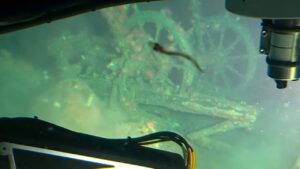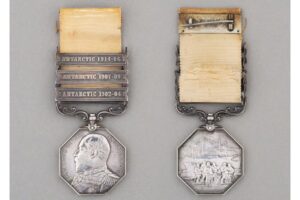Renowned arctic explorer and ExplorersWeb editor, Jerry Kobalenko, has been awarded the prestigious Polar Medal by Canada’s Governor General, Her Excellency the Right Honourable Julie Payette, in a recent ceremony to honour remarkable Canadians.
The Governor General presents honours to mark significant contributions to Canadian society. The Polar Medal celebrates Canada’s northern heritage and recognizes persons who render extraordinary services through significant scientific contributions, further the knowledge of the Canadian north or explore the region.
In awarding the medal, the Governor General noted, “Jerry Kobalenko has skied, hiked, sledded and kayaked more than 16,000 kilometres through the High Arctic over the course of 30 separate expeditions. A professional writer, photographer and ardent arctic adventurer, he has brought his love, passion and knowledge of Canada’s north to a broad national and international audience through his many publications and lectures.”
This week, ExWeb caught up with Jerry Kobalenko to find out what the award means to him and how his passion for the Arctic region developed.
EW: What motivated you or peaked your interest in Arctic exploration?
JK: There are those of us who live very logical lives and others are victims of their obsessions. The Arctic was in me deeply or strongly enough that it just came to the surface on its own. One day, I just had the idea to do an arctic expedition and I began to prepare for it. I had very little experience camping or in winter, and I’d never skied before. My only advantage was that I was fairly fit. I was a marathon swimmer and it turned out I‘m a fairly well-organized guy. I prepared methodically and skied 600km alone across Labrador in midwinter. That was my first expedition.

Jerry Kobalenko on his first Labrador expedition. Photo: Jerry Kobalenko
Again I had no background — I was a kid from Montreal. I didn’t have any adventurous role models. I just liked the outdoors but hadn’t done much in it. It just began with this crazy idea. I followed up on it and it changed everything.
It was the hardest thing I’d ever done at the time and possibly still the hardest thing I’ve ever done, because I was learning as I went. It was extremely cold, and my gear was good, but not as good as it is today. Still, I fell love with the Arctic and in particular, with manhauling. I’ve been travelling north ever since.
EW: When was your first expedition?
JK: 1984
EW: How many expeditions would you say you’ve done?
JK: It depends on what you call an expedition: My definition is something that is A to B and relatively long. I’ve done 20 sledding expeditions, about 15 kayak expeditions and some backpacking trips. But the problem with backpacking in the Arctic is you don’t go for a long weekend, you go for several weeks and the packs are stunningly heavy.
I’ve carried a 50-kilo pack and the primary takeaway memory is the weight. That’s why I prefer sledding and kayaking: The vehicle bears the burden. There are things you can do backpacking that you can’t do with those things, but backpacking for a month is basically voluntary suffering.
EW: What do regard as your most memorable expeditions?
JK: The first one, of course. Then in 1986, I discovered Ellesmere Island. I was a journalist and went there to do a magazine story and fell in love with the place and kept going back.
One of the simplest journeys I did was to see exactly how fast I could pull a sled. I picked a 500km route on Ellesmere Island between the Eureka Weather Station, which is half-way up on the west side, and Grise Fiord, the only civilian habitation on the island. I skied but mainly walked, because the windblown snow was hard. I covered the 500km in 11 days.

Kobalenko sledding in the Arctic. Photo Jerry Kobalenko
So I can understand the challenge faced by Eric Larsen, who is trying to break Christian Eide’s speed record to the South Pole. That pace is extremely difficult. He has it harder than I did. I was alone too, but he’s going uphill, and the winds in Antarctica are much worse. Maintaining an average of 47-48+ km per day takes fitness, long hours and good snow, and you have to keep pushing. At that speed, you don’t learn anything about the place except how to travel there. That was in ’89 and I never did another one like it. It was an experiment.
After that, I did a beautiful manhauling trip in ’97 with a partner. We started at the same Eureka Weather Station on Ellesmere and went all the way up to the north coast and then partway east, before doubling back across to Axel Heiberg Island. We then went down its west side, crossed Axel and returned to Eureka, covering 700km in a month. It was also the first trip where I began to get seriously interested in Arctic history.

Alexandra and Jerry Kobalenko kayaking Labrador’s Torngat Mountains. Photo: Jerry Kobalenko
For the first several years, I was only interested in using the Arctic as a gymnasium. Then I began to get more interested in photography, and finally history. Since ’97, most of my trips have had a historic component. What I often do now is retrace historical routes and try to interpret them from the perspective of an experienced traveller.
EW: What would you say is your most satisfying expedition?
JK: To be diplomatic, I’d have to say it was the first one with my then-girlfriend, Alexandra. We were on our 6th date and we spent two months alone together on Devon and Axel Heiberg Islands. We decided to get married at Truelove Inlet on Devon Island and we’ve been married almost 19 years now.
EW: If you weren’t exploring, what else would you be doing and what other interests do you have?
JK: I was a writer before I was a traveller. Writing and photography have always been a part of what I do. I bought my first camera for that first expedition because I wanted to write a magazine piece on the expedition and I knew magazines needed photos. So I reluctantly took up photography. I thought it would get in the way of the experience, and it did, but I enjoyed it.
I have typically averaged two months a year travelling. There have been years where it was five months and other years zero, when I’m working on a book, for example. I’ve spent a good deal of time researching, planning trips, making a living. I was a staff magazine editor for ten years. Then a photographer and journalist.

Ice cave on Ellesmere Island. Photo: Jerry Kobalenko
EW: That first article, did you manage to sell that?
JK: It’s an interesting part of the story: I did that first expedition out of curiosity or physical restlessness. Afterward, I wrote the story, then approached an outdoor magazine with it. The editor liked the piece and published it. A few months later, I happened to be moving to Toronto, where the magazine was based. The editor invited me to the office and offered me a job as a staff writer because she’d liked the story so much.
I’d done that Labrador expedition for completely amateur reasons, but it ended up changing everything. Suddenly I was getting a full-time salary while improving my writing, and I could ask the professional photographers who worked for us snoopy technical questions about their craft. That first expedition turned out to be the shrewdest career move I’ve ever made.
EW: Is there an expedition that you’ve always wanted to do?
JK: Lots of them. I’ve never really had the institutional support that some people have had from, say, National Geographic or Red Bull. I’ve mainly been a dirtbag trying to scrounge things together. In order to do that, you have to make compromises. One of the things you do is keep half a dozen potential projects up in the air until the door of opportunity to one of them opens a crack. Then you jump on it. So I’ve always had many more things that I’ve wanted to do than I am able to.
EW: What’s on the top of your list?
JK: I’m working on a book on Labrador right now, which will be finished next year, so I’ve completed my Labrador travels, except some personal odds and ends. The other book I wanted to write was on Russia. I travelled Russia a great deal in the past, and studied the language, but will probably not get the chance to write the book because I’d need to travel there extensively again and it might not be affordable.
EW: Have you ever been in a dangerous situation where you thought “I’m in big trouble here?”
JK: In terms of objective danger, the Arctic is one of the least dangerous wildernesses. In the mountains where I live, people die every year from avalanches. You can fall off a mountain, you can be hit by a falling rock. Here, gravity is dangerous in many ways. The Arctic is not a dangerous place at all. The only objective danger is polar bears. I’ve had 13 very close encounters with bears that were interested in me. I say 13 because you never forget each one.
EW: Do you have any expeditions locked in for the future?
JK: In 2020, I’m going to do a sledding expedition on Baffin Island with Ash Routen. We’re going to pull sleds for 700km from Clyde River to Pond Inlet. The route’s been done a few times, it’s just a beautiful trek and manhauling is a beautiful way of life.

The Polar Medal. Photo: Alexandra Kobalenko
EW: What does the Polar Medal mean to you?
JK: I’m a guy who has gone his own way all his life. I’ve been an outsider in a lot of ways. Then suddenly the Queen’s representative is pinning a medal on my chest and saying, “Thank you for your service.” It was all tremendously exciting, to be perfectly honest, and totally unexpected. Some kind and influential person nominated me and I have no idea who it was. One day, I had a phone call out of the blue from the Governor General’s office saying, “Congratulations, the Governor General has awarded you the Polar Medal. Do you accept?” I did.






